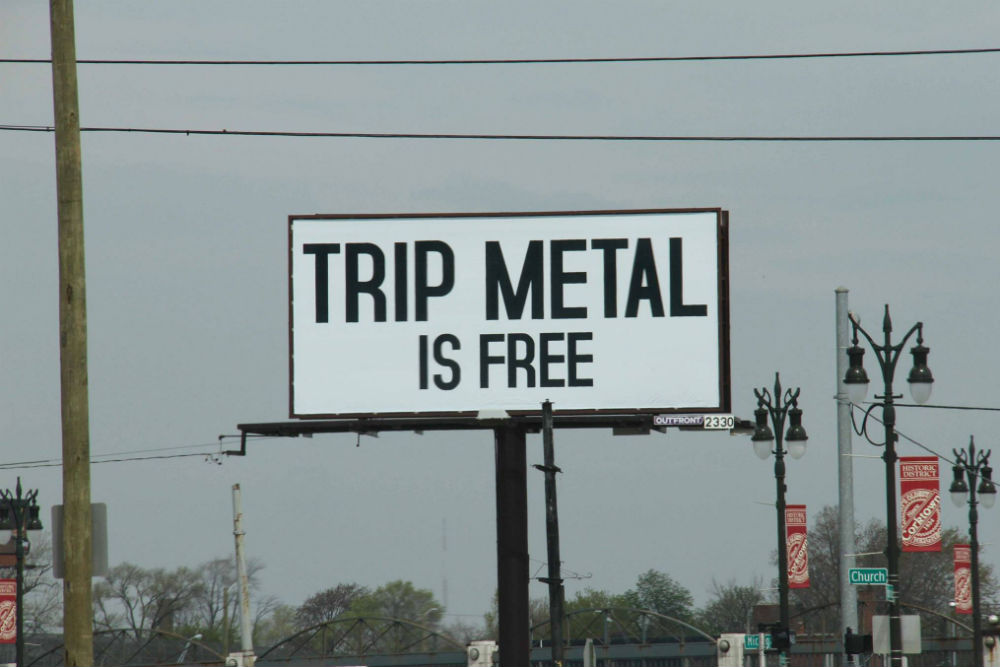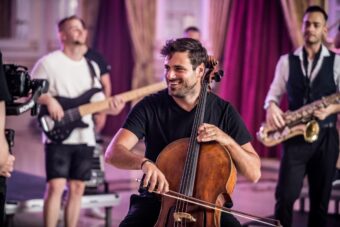As a study in contradictions, the Mexicantown region of Detroit delivers. A lush, sprawling park sits next to rows of vacant brick buildings and lots overflowing with weeds. Faded advertisements and vivid murals alternate. Yet markets, convenience stores, and restaurants proliferate; a weird vitality teems. This was, perhaps, the ideal setting for an uncompromising underground music extravaganza.
In and around Mexicantown’s El Club bar — where the musical component of the first and final Trip Metal Fest raged from Friday, May 27, through Sunday, May 29 — that odd, expectant energy gathered. As the fest’s hundreds of pilgrims (bohos, punks, hipsters, and the more conventionally dispositioned) mingled with neighborhood characters, the mood was mellow. The festival’s organizers included Nate Young of noise godfathers Wolf Eyes, who has indicated that Trip Metal Festival was a singular occurrence. Given its sheer scope, this is understandable; after all, Trip Metal comprised three full evenings of music, with assorted daytime panel discussions and film screenings held at other venues.
Shrouded in smoke-machine fogs, the performers made every moment count. Many served up hearty helpings of tinnitus-encouraging noise, while others opted to juggle or collide genres, illustrating the depth and breadth of experimental sound.
The festival’s first set doubled as its most palpably dangerous. Wearing a macabre monster costume while strangling a homemade noise scepter held above his head, San Francisco’s Rubber O Cement thrashed and danced. His brand of noise music — raw, improvised, and pointedly strychnine — metamorphosed from half-moment to half-moment. A violent transformation appeared to be underway: an exorcism, perhaps, or a panic attack. (I was reminded, slightly, of a blistering, religiously informed performance by North Carolina’s Clang Quartet at Ende Tymes 2014.)

Also Read
The Best Albums of 2023 (So Far)
This was the first in a series of theatrical gestures, where the impact was lessened if you were outside, or listening with eyes closed. For Pod Blotz, her throbbing, temperamental techno was only half the battle. The Los Angeles-based musician emerged in a cross between a beekeeper’s outfit, a hazmat suit, and the Doom Patrol character Negative Man, accessorizing evocatively as surreal black-and-white collages swarmed in the background. She struggled with a large spool of silver ribbon as the sound crested into loud, hypnotic scraping; she donned a silver mask framed by a disc, jerking like a marionette when the music turned abrupt and ugly. After draping a white sheet over her head, she began to sing — a gorgeous conclusion to an extended, haunting metaphor that felt nakedly personal.
Magic was front and center at the beginning of Panicsville’s set, with one member of the Chicago noise group cycling through tricks at varying degrees of difficulty (linking and unlinking thin metal hoops, turning flames into rainbow streamers, pretending to sever his arm). Instructional magic videos, featuring other standard tricks, flickered bemusedly on the wall behind the group. Once this aspect receded, it was easier to focus on and savor the sputtery, scuttling electronics this trio excels at: a furious string of clanks and pocks and taps, as though unspecified objects were being broken and shaken within themselves. The ending — in which the tones exploded in a video-game spasm, then collapsed into malevolent drone — proved far more stirring than the magic-hour opening.
Crouched over cases and consoles situated upon a small table, Hollywood man-in-black Joseph Hammer pulled on a white glove. His was an eerily recombinant magic: a lurching AM signal that cherrypicked and flicked snatches of traditional rock songs and world-music tunes even as it descended into horror-movie-score madness. Hammer’s sound was never static. It buzzed, stippled, and quickly became dafter — more tumultuous, more oppressively fractal.
Much distortion-soaked mischievousness flowed from tables and stands. St. Louis duo Brain Transplants wrenched circular, sandblasted howls from their gear. Cotton Museum and Apetech teamed up for a gong-fueled assault that was easily the most punishing of the entire weekend. Wolf Eyes’ Nate Young, Nautical Almanac’s Twig Harper, and Andrew W.K. scoured El Club with Phantom of the Opera synth-pomp. Detroit’s Sick Llama translated electronics, tapes, a clarinet, and a prone guitar into a tantalizingly comprehensive trailer for the coming apocalypse.
The guitar, meanwhile, was in full, glorious effect. Cross-legged on a chair, Toronto’s Drainolith sketched a spectral, fuzzed-out blues weighted with conversational, baritone vocals. Rochester, New York’s Pengo conjured surging electronic, sample-flooded tornadoes that its guitarist helped guide in and out of intense motorik vamps. Between their own electronics and a guitar, Detroit’s Creode stirred a strafing, jittery cauldron of colors and tones.
Two mysterious units found unusual directions to travel with the instrument. Wooden Highway utilized the ax as an anchor for a set of subtle, experimentalist folk, threading together a short-circuited, recurring synth loop, fluttering flutes, and nocturnal field recordings. Shades, on the other hand, overloaded their sound palette, pitting three Roland synthesizers against two guitars in service of a levitating, phased-beyond-belief prog-techno adventure. The sound was reminiscent of Excepter and the lost Don Fleming LP, jojo ASS RUNne — only quadrupled, and turned past 11.
Music, regardless of genre, may be thought of as declaration. But declaration isn’t necessarily engagement — that alchemy where performance gives way to true interaction, where entertainers ignite audiences, where psychic walls are more or less demolished. Chicago’s Jamal Moss, whose stage name is Hieroglyphic Being, led an epic improv set that featured Sun Ra Arkestra horn players Danny Ray Thompson and Marshall Allen. The collision and collusion of horns, flutes, and Moss’ cosmic house seemed like a provocation, a tempest of white-hot jazz, cold rave, and pastiche Kraftwerk: genre confusion as pitched, inter-generational debate.
You could feel Baltimore’s Scroll Downers join the crowd — their knotty, tangled post-punk, its cascade of scat vocals and vocal loops, its ecstatic frontwoman thrashing from stage to floor and back again, a one-woman pit. Fellow Baltimoreans Nautical Almanac took things a few steps further with an incense-suffused set that rolled together hypnotherapy and aromatherapy sessions; affirmations, chimes, and hand drums made dizzying common cause with turbulent, babbling beats that, at moments, zoomed past like shrapnel.
“You are who you are.” In five words, experimental chanteuse MV Carbon, formerly of Metalux, summarized the Trip Metal ethos. On stage and in the audience, inclusion reigned as a guiding principle; this was a realm where every fashion, sound, and manner went in peaceful co-existence, where violence never broke out. A sense of goodwill and good cheer prevailed all weekend, in contrast to the karmic havoc embodied in many of its performances.
Carbon’s set was the festival’s most memorable — no mean feat, given the field. In the New York City-based musician’s hands, a Siri-like vocal doubled and tripled; a synth chord rose, swelled, wavered, was distended, and exploded, as a bone-throbbing bass and gang of vocals joined in. This set was a party, and as the intensity level grew, Carbon swayed, danced, moved. Her fingers jabbed at a live turntable, prodding a restless groove deeper into buzzes, convulsions, shudders. Organs bubbled from a mix so layered, loud, and impenetrable that it seemed almost willfully eternal. Like a late-’70s Suicide concert — life-affirming, intense, bone-rattling — it didn’t feel like something that could ever actually conclude. A keyboard was lifted, slammed, mashed, and then that was that: silence, the end of a mutually cathartic experience.




